Implantology

Dental Implant
When a tooth is lost due to injury or disease, a person can experience complications such as rapid bone loss, defective speech, or changes to chewing patterns that result in discomfort. Replacing a lost tooth with a dental implant can significantly improve the patient's quality of life and health. Dental implant systems consist of a dental implant body and dental implant abutment and may also include an abutment fixation screw. The dental implant body is surgically inserted in the jawbone in place of the tooth's root. The dental implant abutment is usually attached to the implant body by the abutment fixation screw and extends through gums into the mouth to support the attached artificial teeth.
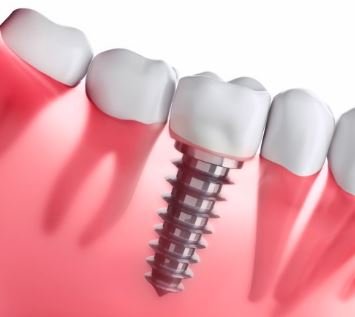
Immediate Loading Implantology
Immediate implant placement is when an implant is placed at the same time as the natural tooth is extracted The technique was developed in response to patients’ growing demand for quicker treatment and faster time-to-teeth. In suitable cases, immediate placement and immediate loading offer an array of benefits for the patient, including shorter treatment time and significantly reduced time (if any) spent with a gap in the dentition since the esthetic restorations are provided on the day of surgery

All on 4
All On 4 is a dental implant technique where the upper or lower set of teeth are replaced with just four implants. These four Implants act as a support mechanism for the placement of a new set of fixed teeth. With the All On 4 dental implant procedure, the posterior implants are tilted 45° towards the rear of the mouth and placed into the anterior maxilla, a region of the jaw with higher bone density. Compared to other implant methods, the All On 4 technique doesn’t require the same density of bone in order to secure the implant
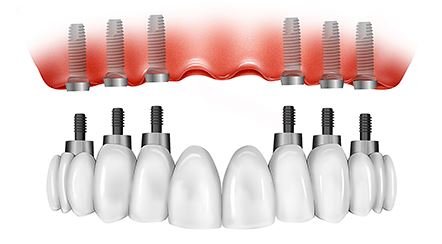
All on 6
The All-on-6 treatment was designed for immediate use. This procedure is used to replace the entire upper or lower set of teeth. In fact, hundreds of thousands of patients have benefited from restored teeth since its inception and is a stronger, healthier replacement for dentures. The procedure creates a permanent prosthesis by using 6 dental implants which act as an anchor for a bridge or over-denture. Six implants are placed in the lower or upper jawbone to permanently anchor prosthetic teeth in place. Your dentist will conduct a thorough examination, taking x-rays and scans to assess the anatomical structures in your mouth and assess bone loss and impressions will be made to create your smile. Over time, the implants that are placed in the jaw will fuse to the jawbone, mimicking the natural roots and giving you a more natural smile that lasts.

All on 8
All on 8 dental implants are used in patients that require extra security of their full arch implants. This could be due to poor jawbone density, irregular shape of the mouth, or any other issue that your dental surgeon will find.
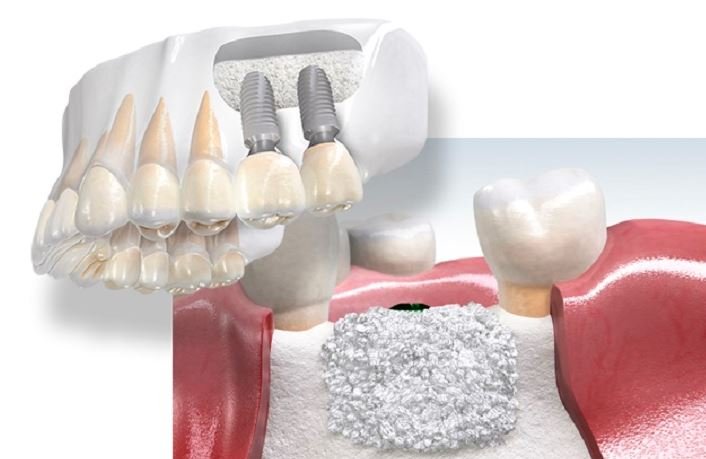
Bone Grafting
Bone grafting in dental implants is a mandatory technique in some cases, in order to replenish and recreate part of the jaw bone that has gone away, increase the jaw bone volume, and be eligible to integrate and support the implant post. Bone grafting in dental implants is used to implant dentures into jaw bone to replace the lost root. Bone grafting technique in dental implant will be implemented 9 – 12 months before placement of the implant, to ensure that the newly implanted bone area is stable and strong enough to integrate and hold the implant. Bone grafting in dental implants is conducted when the quality and quantity of alveolar and maxillary bone of tooth loss are not eligible for Titanium implant.The autologous or artificial bone will be implanted into the position of missing teeth in different cases. After a period of time when the bone is fully integrated with the tooth cavity, the jaw of the tooth is missing, the doctor will conduct Implant pier.
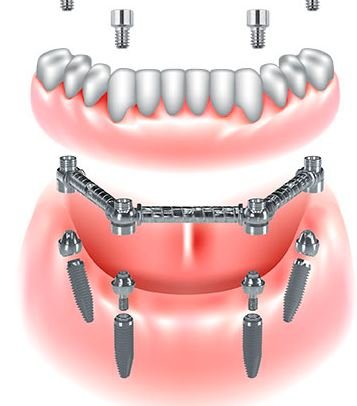
Implant prothesis with a bar
A bar-retained overdenture with dental implants is an ideal choice for patients who need complete tooth restoration in the upper and/or lower arch of the mouth. A bar preserved overdenture is a removable prosthesis that replaces missing teeth in the mouth.
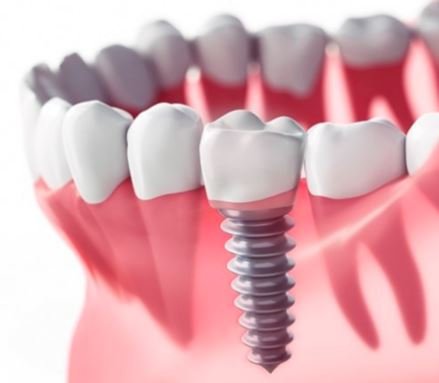
Implant prothesis with locator
Denture locator implants are a specialized set of dental implants that are physically inserted by a dental surgeon at strategic points in the jaw to provide solid, fixed-position anchors. These anchors are what is used to physically connect the denture appliance to the jaw.
Dental crowns and bridges
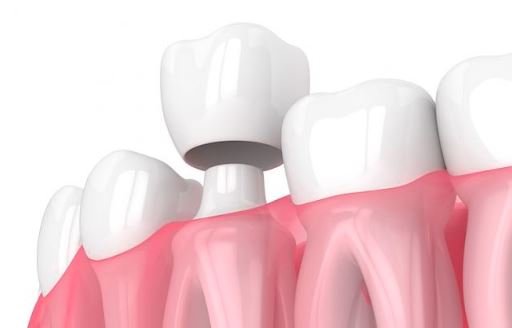
Crown on natural tooth
Over time, your teeth can get damaged. This can happen for a variety of reasons, like tooth decay, injuries or just use over time. Your teeth can lose their shape or size. Dental crowns are tooth-shaped “caps” that can be placed over your tooth. Think of it like a snug hat for your tooth. The crown restores the tooth’s shape, size, strength and a beaty appearance. The dental crown is cemented into place on your tooth and it covers the visible portion of the tooth.
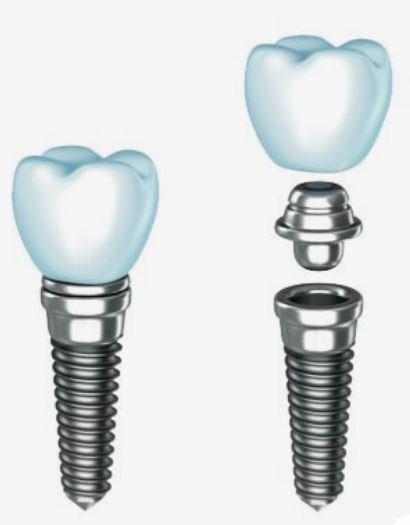
Crown on an implant
An implant crown is an artificial tooth that is fixed to the jaw or cheekbone, which gives it the strength and durability of a regular tooth. Once fitted, an implant crown connects to the bone through a process called osseointegration, whereby new bone cells grow around the screw-like “post” and keep the crown secure
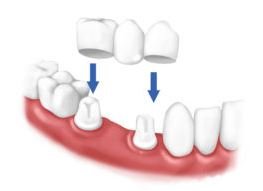
Bridge on natural teeth
A dental bridge is a set of three or more crowns connected to one another. The two crowns on the ends—the “abutment teeth”—anchor to either your existing teeth or to dental implants. The crowns between these anchors—the “pontics”—bridge the gap where teeth are missing.
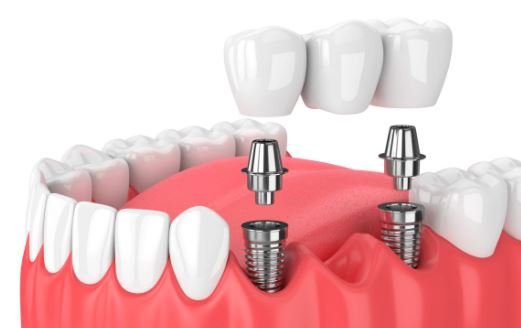
Bridge on implants
Typically, one implant is surgically placed for every missing tooth, and these implants hold the bridge in position. If one implant for each missing tooth isn't possible, the bridge may have a pontic suspended between two implant-supported crowns.
Aesthetic dentistry

Dental veneers
Dental veneers (sometimes called porcelain veneers or dental porcelain laminates) are wafer-thin, custom-made shells of tooth-colored materials designed to cover the front surface of teeth to improve your appearance. These shells are bonded to the front of the teeth changing their color, shape, size, or length

Composite aesthetic fillings
Aesthetic, composite filling. This type of filling is quick, simple and its colour matches the teeth perfectly. During the preparation our dentists put effort in creating the enamel grooves, as well. This means that the upper surface of the tooth will look realistic and be functionally proper

Teeth whitening
Whitening teeth with laser to have greats result
